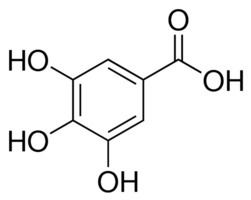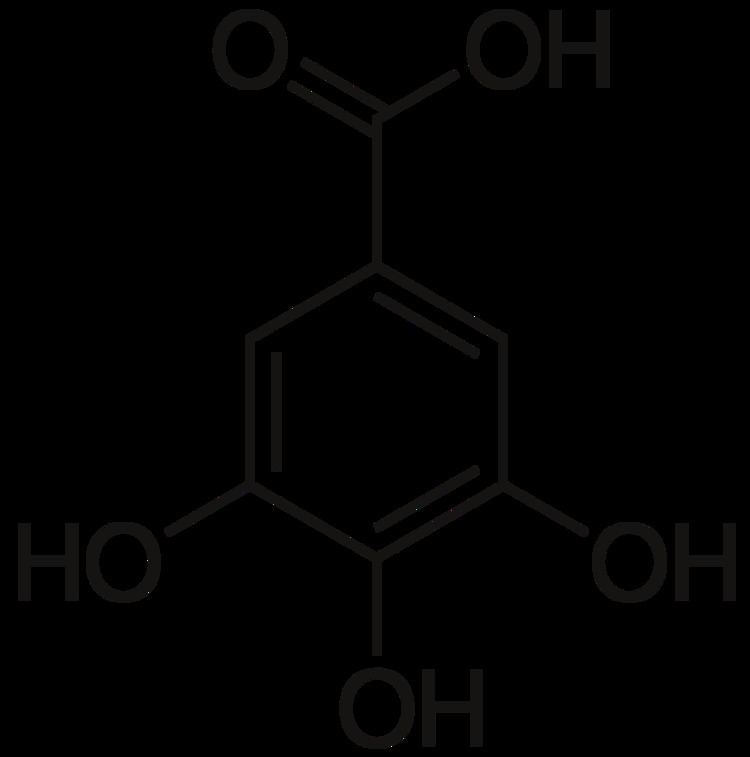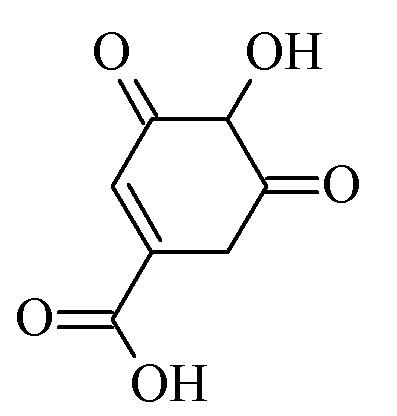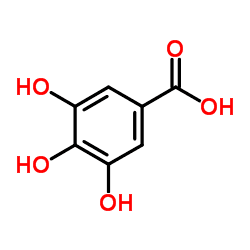Formula C7H6O5 Density 1.7 g/cm³ | Molar mass 170.12 g/mol | |
 | ||
Related Related compounds Appearance White, yellowish-white, or; pale fawn-colored crystals | ||
Gallic acid (also known as 3,4,5-trihydroxybenzoic acid) is a trihydroxybenzoic acid, a type of phenolic acid, found in gallnuts, sumac, witch hazel, tea leaves, oak bark, and other plants. The chemical formula of gallic acid is C6H2(OH)3COOH. Gallic acid is found both free and as part of hydrolyzable tannins. The gallic acid groups are usually bonded to form dimers such as ellagic acid. Hydrolyzable tannins break down on hydrolysis to give gallic acid and glucose or ellagic acid and glucose, known as gallotannins and ellagitannins respectively.
Contents
- Historical context and uses
- Biosynthesis
- Degradation
- Conjugation
- Health effects
- Natural occurrence
- Production
- Spectral data
- Esters
- References

Gallic acid forms intermolecular esters (depsides) such as digallic and trigallic acids, and cyclic ether-esters (depsidones).
Gallic acid is commonly used in the pharmaceutical industry. It is used as a standard for determining the phenol content of various analytes by the Folin-Ciocalteau assay; results are reported in gallic acid equivalents. Gallic acid can also be used as a starting material in the synthesis of the psychedelic alkaloid mescaline.

The name is derived from oak galls, which were historically used to prepare tannic acid. Despite the name, gallic acid does not contain gallium. Salts and esters of gallic acid are termed "gallates".

Historical context and uses
Gallic acid is an important component of iron gall ink, the standard European writing and drawing ink from the 12th to 19th century with a history extending to the Roman empire and the Dead Sea Scrolls. Pliny the Elder (23-79 AD) describes his experiments with it and writes that it was used to produce dyes. Galls (also known as oak apples) from oak trees were crushed and mixed with water, producing tannic acid. It could then be mixed with green vitriol (ferrous sulfate) — obtained by allowing sulfate-saturated water from a spring or mine drainage to evaporate — and gum arabic from acacia trees; this combination of ingredients produced the ink.
Gallic acid was one of the substances used by Angelo Mai (1782–1854), among other early investigators of palimpsests, to clear the top layer of text off and reveal hidden manuscripts underneath. Mai was the first to employ it, but did so "with a heavy hand", often rendering manuscripts too damaged for subsequent study by other researchers.
Gallic acid was first studied by the Swedish chemist Carl Wilhelm Scheele in 1786. In 1818 the French chemist and pharmacist Henri Braconnot (1780–1855) devised a simpler method of purifying gallic acid from galls; gallic acid was also studied by the French chemist Théophile-Jules Pelouze (1807–1867), among others.
Gallic acid is a component of some pyrotechnic whistle mixtures.
Biosynthesis
Gallic acid is formed from 3-dehydroshikimate by the action of the enzyme shikimate dehydrogenase to produce 3,5-didehydroshikimate. This latter compound tautomerizes to form the redox equivalent gallic acid, where the equilibrium lies essentially entirely toward gallic acid because of the coincidentally occurring aromatization.
Degradation
Gallate dioxygenase is an enzyme found in Pseudomonas putida that catalyses the reaction
gallate + O2 → (1E)-4-oxobut-1-ene-1,2,4-tricarboxylate.Gallate decarboxylase is another enzyme in the degradation of gallic acid.
Conjugation
Gallate 1-beta-glucosyltransferase is an enzyme that uses UDP-glucose and gallate, whereas its two products are UDP and 1-galloyl-beta-D-glucose.
Health effects
It is a weak carbonic anhydrase inhibitor. In basic research, gallic acid extracted from grape seeds has been shown to inhibit the formation of amyloid fibrils, one of the potential causes of Alzheimer's disease and Parkinson's disease. One study indicated that gallic acid has this effect on amyloid protein formation by modifying the properties of alpha-synuclein, a protein associated with the onset of neurodegenerative diseases.
Gallic acid is classified as a mutagen and a teratogen.
Natural occurrence
Gallic acid is found in a number of land plants, such as the parasitic plant Cynomorium coccineum, the aquatic plant Myriophyllum spicatum, and the blue-green alga Microcystis aeruginosa. Gallic acid is also found in various oak species, Caesalpinia mimosoides, and in the stem bark of Boswellia dalzielii, among others. Many foodstuffs contain various amounts of gallic acid, especially fruits (including strawberries, grapes, bananas), as well as teas, cloves, and vinegars.
Production
Gallic acid is easily freed from gallotannins by acidic or alkaline hydrolysis. When gallic acid is heated with concentrated sulfuric acid, rufigallol is produced by condensation. Oxidation with arsenic acid, permanganate, persulfate, or iodine yields ellagic acid, as does reaction of methyl gallate with iron(III) chloride.
Spectral data
Reference
Esters
Also known as galloylated esters:
